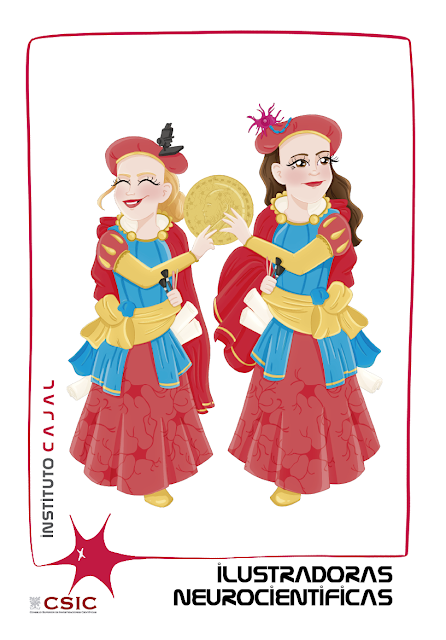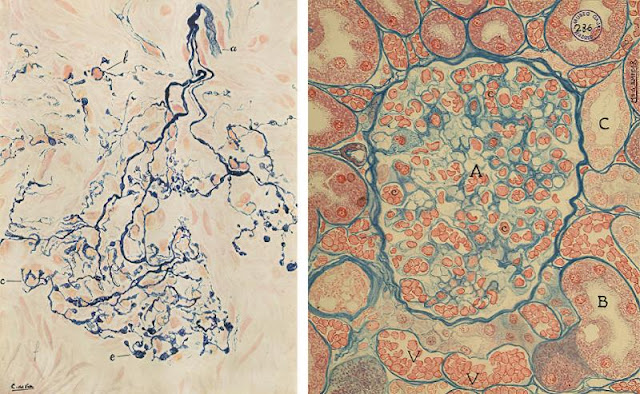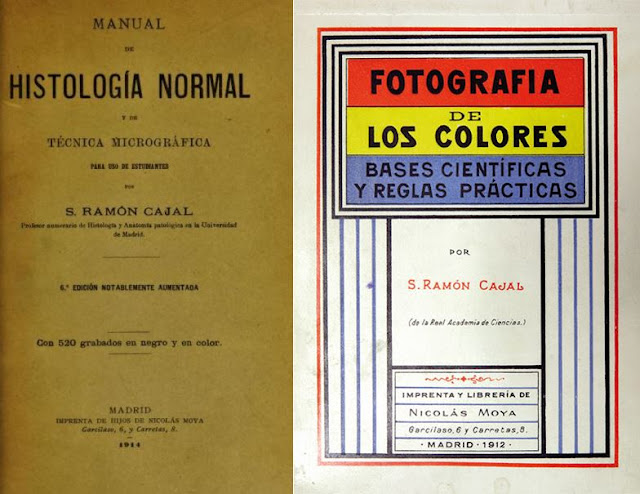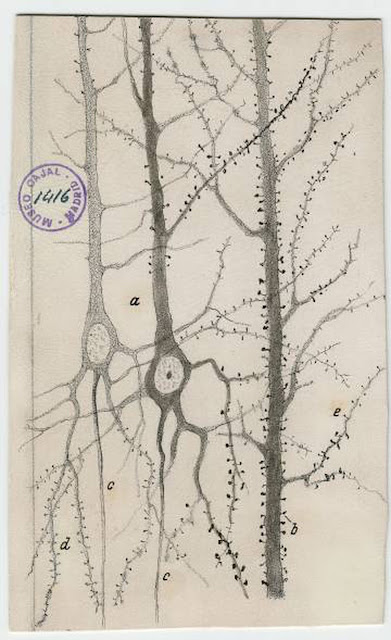PAGES OF GOLD
NEUROSCIENTIFIC ILLUSTRATORS FROM THE CAJAL SCHOOL: SCIENTIFIC ILLUSTRATION AS A DISCIPLINE
We present our Pages of gold: the neuroscientific illustrators who worked with Santiago Ramón y Cajal and his disciples at the Neurological School of Madrid.

At the beginning of the 20th century, a few women walked among microscopes, brain samples, nervous tissue preparations and drawing material to illustrate the science produced by the most brilliant of the Spanish scientific schools, the one created around the figure of Santiago Ramón. and Cajal in Madrid, named director of the Biological Research Laboratory after obtaining the Moscow Prize at the XIII Congress of Medicine in Paris, in 1901.
If there were illustrators in the Cajal School, it is because scientific illustration was and is an essential pillar of science communication. In the words of Elena Giné, one of the authors of these two works: “Cajal and some of his disciples, such as his brother Pedro, Domingo Sánchez, Achúcarro, del Río-Hortega, De Castro and Lorente de Nó, were authentic masters of illustration of his observations”, but not Francisco Tello (Horse of Pentacles of the neurodeck), who needed technical help to make his illustrations. Although we have only been able to rescue the full name of two illustrators, Conchita del Valle and Mª G. Amador, because they sign 84 and 71 drawings, respectively, there are another 141 illustrations with an unidentified acronym (ERNA) and 247 more unsigned, which It gives an idea of the volume of work that would have been carried out, almost entirely, by women.
Just as words from one language are translated into another taking into account who they are addressed to, the illustrator also “translates” complex scientific topics, processes or objects into visual language in a precise, clear and objective way so that the audience to whom they can understand them can understand them. their creations are destined. As in translation, also the first step of scientific illustration is to investigate thoroughly [3] to know perfectly what is going to be illustrated, because you can only draw what you understand.
The illustrators of the Cajal School were experts in capturing reality as it was seen under the microscope. They had a great ability to extract the maximum number of details from the preparations to incorporate them into their illustrations, and to do so they had to have solid knowledge of the anatomy of the nervous system and a good understanding of the physiological processes they support. Thus they were able to make illustrations at the level of the quality of the scientific works of Cajal and his disciples. Proof of this is that Conchita del Valle collaborated with Fernando de Castro in the illustrations of his work on the carotid sinus, despite the fact that this disciple of Cajal was an excellent draftsman.

Illustrations by Conchita del Valle (left) and María G. Amador (right). The images show sensory innervation of the carotid body (left) and a renal corpuscle (right).
[Fernando de Castro Archive]
Since their origins, scientific illustrations have been the indispensable complement to research work, with scientists themselves as the first promoters of the discipline, both for educational purposes and to publicize the results of their research. Currently, they are also essential tools within dissemination strategies that seek to bring science closer to the general public.
Until the end of the 19th century and the beginning of the 20th century, drawings facilitated the internationalization of scientific work, because they allowed knowledge to be communicated without the need for supporting texts that frequently had to be translated into French or German, because English was not yet the language of The science.
“Good drawing, like good microscopic preparation, are pieces of reality, scientific documents that retain their value indefinitely and whose revision will always be profitable, whatever the interpretations to which they have given rise.” Ramon y Cajal [4]
Always concerned with representing reality in the purest and most objective way, Cajal used his extraordinary artistic gifts to represent in two dimensions the three-dimensional structures that he saw under the microscope. He was also helped by his deep knowledge of photography, another field that he explored in search of the best techniques to “capture reality as it is.” His disciple Fernando de Castro Rodríguez [5] says that “During the years 1917-18, Cajal devised photography that he called biplanar and multiplanar […] with the desire to be able to achieve […] the three-dimensional impression of neurons “, similar to a forest, during the projection of the slide consisting of a set of two or three photographs that had previously been obtained of the same subject.” With such a photographic procedure it seems that he achieved “beautiful three-dimensional images” of the nervous tissue and the networks of the injected blood capillaries.
Although photomicrography began to be used in Cajal’s laboratory in the early 1920s, it could not compete with the quality and quantity of information provided by drawings of tissue preparations. At that time, the techniques for staining cells gave a very opaque, almost black background, which made it very difficult to take easy-to-interpret photographs. This is how hand drawing became the perfect complement to the Golgi method and other histological techniques at the dawn of Neuroscience [1], while photographic chemistry was of great help to make this staining technique more reliable, with which Cajal demonstrated the individuality of nerve cells. All of this knowledge that he collected, duly illustrated, in his Manual of normal histology and micrographic technique, published in 1899 and in his book Photography of colors. Scientific bases and practical rules, published in 1912.

Natural Sciences are a very visual field. We find nature beautiful because we are part of it. And because nature is part of us [5]. Of the countless natural wonders, the brain is one of the most complex and (still) mysterious, in addition to being the only one that allows us to appreciate them. Javier De Felipe, researcher at the Cajal Institute, defines artistic creativity as “a product of the human mind [that] we can enjoy because we have a brain equipped for it.” There are more and more scientists attracted by the relationship between neurons, beauty and creation [6], but in this field, as in so many others, the model to follow is Santiago Ramón y Cajal.
Halfway between science and art, scientific illustration is a discipline that seeks to synthesize and visually represent scientific information. The sketches served Cajal as a working tool to develop the doctrine of the neuron, because he based his reasoning on the precise and meticulous observation that scientific illustration requires. Drawing forces one to analyze the smallest details of the material being observed, and visually exploring the dendritic spines surely made Cajal understand that they were those special places where the transfer of information between neurons occurred.

Dendrites of pyramidal neurons of the rabbit cerebral cortex. Drawing by Ramón y Cajal.
[Fernando de Castro Archive]
Although “illustration does not seek the magical, unique and unrepeatable moment [of the artist]”, but rather “the absolute data, valid forever, universal and repeatable” because its objective “is the schematic and detached exposition of data on morphology, the life and customs of the subjects represented” [14], it is impossible not to appreciate the beauty of the illustrations signed by Santiago Ramón y Cajal. In them, scientific precision combines wonderfully with artistic delicacy to achieve genius: connecting the shape of nervous structures with their function. And this beauty has allowed Cajal’s drawings to cross the borders of science to tour art museums, filling the pages of books like The Beautiful Brain. The Drawings of Santiago Ramón y Cajal (2017) or inspire artistic currents, such as the surrealism of which Lorca and Dalí were champions [7][8].
Fernando de Castro Rodríguez, a prominent disciple of Cajal, already predicted in 1966 [9] that one day Cajal’s drawings would be considered works of art, even regardless of their scientific value.
«Cajal’s histological drawings… We cannot continue without stopping for a moment at this point, where we could say that here Science becomes Art. His drawings of the nervous system are famous throughout the world. With incomparable skill he faithfully reproduces all the grace and subtlety of the beautiful forms of neurons, and even manages to achieve in a composition – without resorting to the simplicity of the scheme – that we see synthetically reflected the very complex warp of a place or structural nucleus of the brain. medullary. I am convinced that if an exhibition of Cajal’s histological drawings were ever held, they would produce astonishment among the artists and fans of painting and graphics of our time. Leonardo Da Vinci, an exceptional anatomical draftsman, as we know, would surely have been enthused by Cajal’s exotic drawings. Fernando de Castro Rodríguez, 1966.

Currently, the scientific illustrator Román García Mora [10] sees it as more appropriate to speak of “scientific visualization” to encompass the wide range of graphic representation techniques that go beyond traditional illustration. Although today drawing and photography continue to complement each other [11], new technologies and digital support enhance and expand the possibilities of visual communication of science with new formats: infographics, models, three-dimensional digital models, virtual reality, dioramas, applications of software, etc. [4][12]. Nor do advances in immunohistochemistry and immunocytochemistry techniques (working with conjugated antibodies and fluorochromes) combined with new microscopy techniques (fluorescence, confocal, multiphoton) compete with classical illustration, but rather complement it.
Scientific illustration continues and will continue to be the basis of future scientific communication because it fulfills essential functions that are its own, such as [13]:
- the possibility of emphasizing the most significant scientific information,
- highlight details that would otherwise go unnoticed,
- displace scientifically irrelevant elements into the background, or
- make simplifications that facilitate our understanding of complex processes or structures.
Good proof of this is that books with illustrations by Santiago Ramón y Cajal continue to be, in the 20th century, an essential reference for neuroscience.
Have you been curious and want to know more?
GRADES:
[1 ] GINÉ E, MARTÍNEZ C, SANZ C, NOMBELA C and DE CASTRO F (2019) The Women Neuroscientists in the Cajal School. Front. Neuroanat. 13:72. https://www.frontiersin.org/articles/10.3389/fnana.2019.00072/full
[2] NOMBELA C, FERNÁNDEZ-EGEA E, GINÉ E, WORBE Y, DEL RÍO-HORTEGA BERECIARTU J and DE CASTRO F (2021) Women Neuroscientist Disciples of Pío del Río-Hortega: the Cajal School Spreads in Europe and South America. Front. Neuroanat.15:666938. https://www.frontiersin.org/articles/10.3389/fnana.2021.666938/full
[3] LORENZO, Sarela, Martín SOUTO and Marcos A. GONZÁLEZ (2019). Scientific illustration techniques in Natural History. The malacoloxic collections given by USC as a study model. Nova Acta Cientifica Compostelana (Bioloxia), 26: 27-38 (2019) https://revistas.usc.gal/index.php/nacc/article/view/6288
4] GRILLI, Javier, Mirtha LAXAGUEL and Lourdes BARBOZA (2015). Drawing, photography and Biology. Build science with and from the image. Eureka Journal of Science Teaching and Popularization 12(1), pp. 91-108 http://dx.doi.org/10.25267/Rev_Eureka_ensen_divulg_cienc.2015.v12.i1.07 http://reuredc.uca.es
[5] MARLEY, Christopher (2015). Biophilia. Abrams Publishing House (New York), 288 pp.
[6] SÁEZ, Cristina (2010). A brain for art. La Vanguardia, ES, October 16, 2010 https://cristinasaez.wordpress.com/2010/10/22/un-cerebro-para-el-arte/
[7 ] Cajal’s art to explain science, by Javier SAMPEDRO published in the Science/Matter section of the newspaper El País (March 23, 2017) https://elpais.com/elpais/2017/03/22/ciencia /1490185166_393185.htm
Cajal’s drawings, on tour through North America, SINC agency (2017) https://www.agenciasinc.es/print/107087
The beauty of science in the drawings of Ramón y Cajal, by Amado HERRERO. El Mundo, March 1, 2017 https://www.elmundo.es/ciencia/2017/03/01/58b69e0846163f05358b45b8.html
[8] DE CASTRO SOUBRIET Fernando. Article published in the Science/Matter section of the newspaper El País (February 25, 2015). The art that Spain forgets: its science. https://elpais.com/elpais/2015/02/26/ciencia/1424956367_520013.html
[9] Quote taken from the presentation that he made in Madrid in 1966 FERNANDO DE CASTRO RODRÍGUEZ of the work The Photography of Colors. Scientific bases and practical rules, by Santiago Ramón y Cajal, published in 1912 by the Nicolás Moya bookstore in Madrid https://cvc.cervantes.es/ciencia/cajal/cajal_fotocolor/presentacion.htm. Quote taken up by DE CASTRO SOUBRIET and Fernando and Alfonso ARAQUE in their article published in the Science/Material section of the newspaper El País (May 5, 2017): Ramón y Cajal: what is moving in the world and what should move in Spain. https://elpais.com/elpais/2017/04/24/ciencia/1493027674_193847.html
[10] Talk at the Bioemployment Conference 2020 at the Faculty of Biology of the Complutense University of Madrid on Scientific Illustration, by Román GARCÍA MORA, an internationally recognized scientific illustrator, who participates in the CSIC Iberian Flora project. https://www.youtube.com/watch?v=sJO3gu_p78s
[11] Nor can photography currently replace drawing, since it provides a set of flat data without interpretation, so that the document is more faithful, but its demonstrative value is limited [6]. Furthermore, according to [14]: “the line provides [an] expositional clarity that photography cannot achieve.” Therefore, drawing and photography complement each other.
[12] ORTEGA ALONSO, Diego (2019). Artistic personality in scientific illustration: A case study. Crescent Third, 15, pp. 55-72. https://dx.doi.org/10.17561/rtc.n15.4
[13] HERNÁNDEZ MUÑOZ, Óscar (2010). The communicative dimension of the scientific image: graphic representation of concepts in the life sciences. Doctoral Thesis directed by Mr. Antonio Muñoz Carrión, Complutense University of Madrid, Faculty of Fine Arts. 426 pp.
[14] MAYOR IBORRA, José and Mariano FLORES GUTIÉRREZ (2013). The scientific drawing. Introduction to drawing as a language in field work. VAR. Volume 4 Number 9, November 2013: pp. 130-134. https://dialnet.unirioja.es/descarga/articulo/5210178.pdf#:~:text=Las%20cualidades%20principales%20de%20un%20ilustrador%20cient%C3%ADfico%20son,la%20ilustraci%C3%B3n %20digital%20which%20currently%20is%C3%A1%20on%20boom.
SOURCES:
SWANSON, Larry W., Eric NEWMAN, Alfonso ARAQUE and Janet M. DUBINSKY (2017). The Beautiful Brain. The Drawings of Santiago Ramón y Cajal. Abraham Books, 208 pp. https://www.abramsbooks.com/product/beautiful-brain_9781419722271/
RAMÓN Y CAJAL, Santiago (1911). The photography of colors. Scientific bases and practical rules. Introduction: The charms of photography. https://cvc.cervantes.es/ciencia/cajal/cajal_fotocolor/introduccion.htm
Algarabía Magazine, The beauty of the brain https://algarabia.com/la-belleza-del-cerebro/
Scientific illustration. Illustrationscience https://illustraciencia.info/que-es-la-ilustracion-cientifica/#:~:text=La%20ilustraci%C3%B3n%20cient%C3%ADfica%20es%20una%20disciplina%20art%C3%ADstico-cient%C3% ADfica%2C%20whose,concept%20cient%C3%ADfic%20of%20accurate%2C%20clear%20and%20objective.
Planet Tuna YouTube Channel: Scientific Illustration: A Guided Tour https://www.youtube.com/watch?v=5pclISwNvgY
YouTube Channel Illustraciencia: Is scientific illustration necessary for science? https://www.youtube.com/watch?v=3C2zyS_fxoQ&t=763s
